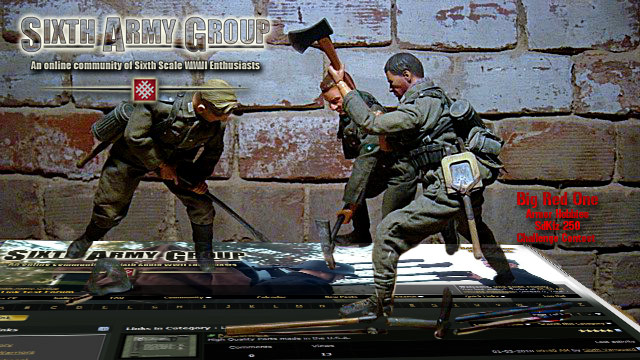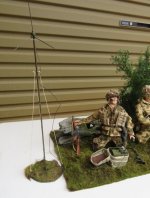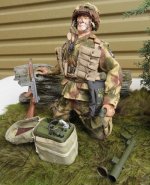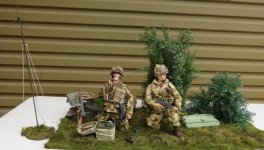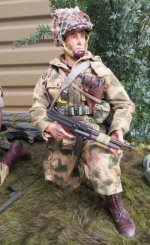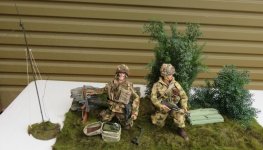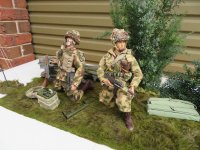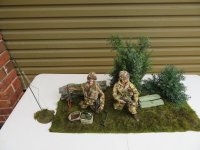SteveKrieg
Company Commander
G'day all,
Well, with the series drawing to an end (wow, has it really been almost a year since I started this venture?) and not too long now 'til the annual model show gets a bad case of 'vertical envelopment' 101st-style, it's finally good to finish a scene that I've been keen on doing since the inception and features as No.3 in the series simply titled 'Pathfinders'.
These guys were found to be essential by both the Brits and the U.S. in providing the guidance to ensure the paratroopers following arrived on the right drop/landing zones though at first the U.S. saw this kind of role as a suicide mission given they'd be small in number and if there's any enemy on the ground at the time then they're sure to cop it which is why the first 'volunteers' were merely soldiers that commanding officers merely wanted out of their unit.
Captain Frank Lillyman would have none of it and it was not long, after reasoning with those high in command - particularly Gen. 'Bill' Lee himself, that to ensure the best chance of success for any airborne op that the pathfinders needed to be of the highest rather than the lowest calibre. Suffice to say, the attitude changed and more abled men got the job.
It's well known that the Normandy drops did not go as planned - far from it - however the 11 pathfinder teams of the 101st that went in were just as impacted by the hazards as the division following. The cloud bank, enemy flak disrupting the drop in the right areas, lost and broken gear, missing personnel and the presence of the German patrols ensured that many teams were not ready by the time the first serials arrived and the nature of the terrain (the infamous bocage) also concealed many of the lights until it was too late and the planes had flown over (which entailed many to turn around and make another run thus doubling the chance of getting hit by flak).
Added to this the intricacies of the ' Eureka' homing beacon with many of the C-47s in the main switching on their 'Rebecca' receivers in order to find their way out of the cloud bank which impacted on the lead aircraft whose job it was to act as the guide for the serials.
The British-designed AN/PPN-1 'Eureka' was an ingenious device and I just had to replicate one (out of plastic card) along with its antenna for this particular scene. The M-227 Signal Lamp was also scratch-built using the same plastic albeit in differing shapes. Time permitting, I'll make a few Delta Lanterns however I'm hoping to get the parts required to finish off the Sherman tank this week and, therefore; the last scene of the Series - 'Relief at Carentan'.
TIl then, enjoy
Well, with the series drawing to an end (wow, has it really been almost a year since I started this venture?) and not too long now 'til the annual model show gets a bad case of 'vertical envelopment' 101st-style, it's finally good to finish a scene that I've been keen on doing since the inception and features as No.3 in the series simply titled 'Pathfinders'.
These guys were found to be essential by both the Brits and the U.S. in providing the guidance to ensure the paratroopers following arrived on the right drop/landing zones though at first the U.S. saw this kind of role as a suicide mission given they'd be small in number and if there's any enemy on the ground at the time then they're sure to cop it which is why the first 'volunteers' were merely soldiers that commanding officers merely wanted out of their unit.
Captain Frank Lillyman would have none of it and it was not long, after reasoning with those high in command - particularly Gen. 'Bill' Lee himself, that to ensure the best chance of success for any airborne op that the pathfinders needed to be of the highest rather than the lowest calibre. Suffice to say, the attitude changed and more abled men got the job.
It's well known that the Normandy drops did not go as planned - far from it - however the 11 pathfinder teams of the 101st that went in were just as impacted by the hazards as the division following. The cloud bank, enemy flak disrupting the drop in the right areas, lost and broken gear, missing personnel and the presence of the German patrols ensured that many teams were not ready by the time the first serials arrived and the nature of the terrain (the infamous bocage) also concealed many of the lights until it was too late and the planes had flown over (which entailed many to turn around and make another run thus doubling the chance of getting hit by flak).
Added to this the intricacies of the ' Eureka' homing beacon with many of the C-47s in the main switching on their 'Rebecca' receivers in order to find their way out of the cloud bank which impacted on the lead aircraft whose job it was to act as the guide for the serials.
The British-designed AN/PPN-1 'Eureka' was an ingenious device and I just had to replicate one (out of plastic card) along with its antenna for this particular scene. The M-227 Signal Lamp was also scratch-built using the same plastic albeit in differing shapes. Time permitting, I'll make a few Delta Lanterns however I'm hoping to get the parts required to finish off the Sherman tank this week and, therefore; the last scene of the Series - 'Relief at Carentan'.
TIl then, enjoy
